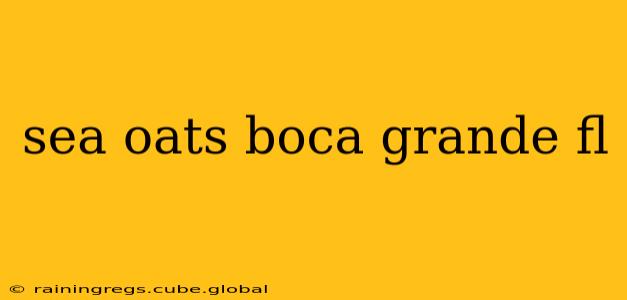Boca Grande, Florida, boasts stunning beaches and a unique ecosystem, with sea oats playing a crucial role in maintaining its coastal beauty and ecological balance. These aren't just pretty grasses; they're vital for shoreline protection and wildlife habitat. This comprehensive guide delves into the importance of sea oats in Boca Grande, addressing common questions and providing valuable insights for residents and visitors alike.
What are Sea Oats and Why are They Important?
Sea oats ( Uniola paniculata) are a native perennial grass species found along the coasts of North America. Their extensive root systems are incredibly effective at stabilizing sand dunes, preventing erosion from wind and waves. This natural defense mechanism is critical in protecting beachfront properties and infrastructure in vulnerable areas like Boca Grande. Beyond erosion control, sea oats provide crucial habitat and food sources for a variety of wildlife, including nesting shorebirds, insects, and small mammals. Their presence contributes significantly to the overall health and biodiversity of the coastal ecosystem.
Where Can I See Sea Oats in Boca Grande?
You'll find sea oats abundantly throughout Boca Grande's beaches. They're particularly prominent along the beachfront dunes, forming a natural barrier between the sand and the inland areas. Take a stroll along Gasparilla Island State Park, or simply wander the public beaches, and you're sure to encounter these impressive grasses. Remember to observe them from a distance and avoid disturbing their delicate root systems.
Are Sea Oats Protected in Boca Grande?
Yes, sea oats are protected in Boca Grande, as they are in many coastal areas of Florida. Damaging or removing them is typically prohibited. These ordinances are in place to safeguard the dunes and maintain the natural beauty of the coastline. It's essential to respect these regulations and contribute to the preservation of this valuable resource. The fines for harming sea oats can be substantial, so mindful observation is key.
How Do Sea Oats Help Protect the Beaches?
As mentioned earlier, the extensive root system of sea oats is the key to their protective function. These roots bind the sand together, creating a stable dune system that resists erosion. This natural barrier acts as a first line of defense against storm surges and high tides, protecting both the environment and human development. The plants themselves also help to trap sand blown by the wind, further building and reinforcing the dunes.
What Animals Depend on Sea Oats?
Sea oats provide critical habitat for numerous species. Many shorebirds use the dense cover provided by sea oats for nesting and shelter. Insects find food and refuge within the plants, which in turn supports the food chain for larger animals. Small mammals might also use sea oats for shelter and protection. The diverse plant and insect life supported by sea oats contributes to the rich biodiversity of Boca Grande's coastal ecosystem.
What is the Best Time to Visit Sea Oats in Boca Grande?
Sea oats are present year-round, but the best time to see them thriving is during the growing season, generally from spring through fall. During this period, the plants are lush and green, showcasing their full beauty. However, a visit anytime offers a chance to appreciate their importance in the coastal landscape.
How Can I Help Protect Sea Oats in Boca Grande?
You can contribute to the preservation of sea oats by staying on designated pathways while on the beach, refraining from disturbing the plants, and educating others about their importance. Supporting local conservation efforts and organizations dedicated to preserving the natural environment of Boca Grande also plays a significant role. Respecting the dunes and the natural environment ensures the long-term survival of these vital plants.
By understanding the significance of sea oats and actively contributing to their protection, we can ensure that Boca Grande continues to benefit from the ecological and aesthetic values they provide for generations to come.
